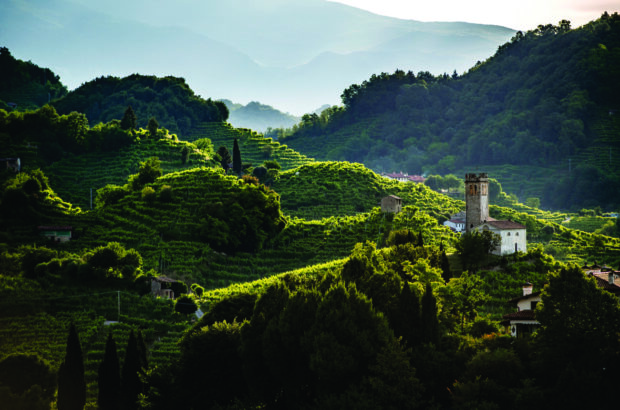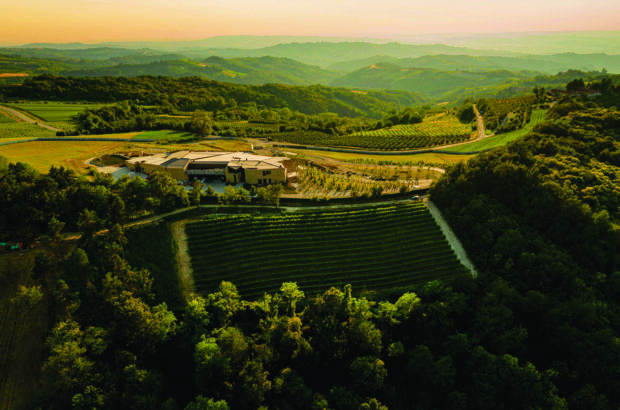- Only one of these varieties is genuinely world-class and that is Albariño.
- Albariño is grown in four separate sub-regions within Rías Baixas.
- Although it is an old grape variety, it is only recently that Albariño has established a world-wide following.
- Albariño is never cheap.
Compiling a list of Spain’s best white grape varieties is like trying to come up with 10 famous Albanians. Even the most fervent hispanophile would be severely pushed to assemble more than two or three. You could make a case for Verdejo and for Albariño, but after that the list starts to peter out. Viura? I don’t think so. Parellada? Maccabeo? Xarel-lo? Airén? Sorry, not really. Palomino from Jerez might just squeeze in – more for the process which turns it into something special than for its own innate characteristics, which make a visit to the recycling centre look exciting – but we’re still short of candidates.
Only one of these varieties is genuinely world-class and that is Albariño, the grape of Galicia in Spain’s Atlantic, northwest corner. Here in the province of Pontevedra sits the denomination of Rías Baixas, the source of many of Spain’s finest white wines. In theory, Spain shares Albariño with northern Portugal, but if you talk to some Galicians, they’ll tell you that the two grapes are different. The variety grown on the Spanish side of the River Miño is finer, they say, while the Portuguese version is called Albariño Doble because of its bigger berries.
No one is quite sure where Albariño came from. One theory is that the grape is related to Riesling, which was brought by pilgrims who came to visit the ‘tomb’ of Saint James in Santiago de Compostella. Manuel Barcala Pereiras of the local consejo regulador is convinced that Albariño has nothing whatsoever to do with Riesling. ‘It’s been grown here for a long time,’ he says: ‘And predates the arrival of the first pilgrims. It could be 3,000 years old.’
Whatever its origins, Albariño is rather special. It draws together flavours and textures found in several other grapes: the complexity of Riesling, the peachy weight of Viognier, the perfume of Pinot Gris, the fresh acidity of Chenin Blanc.
Here on the Atlantic coast, tucked into the hills between inlets, coves and estuaries, Albariño produces some remarkable wines. The grape’s small berries (and resistance to botrytis) make it an ideal variety for the cool, humid conditions of Rías Baixas. It’s not the only grape grown here – there are another 10 permitted varieties – but it’s no surprise that it now accounts for 90% of the area under vine.
Albariño is grown in four separate sub-regions within Rías Baixas’ 1,800 hectares (ha): Val do Salnés in the north and O Rosal, Condado do Tea and Sotomayor in the south. The climate is cooler and wetter in the Val do Salnés than in the other three zones, so wines made exclusively with local fruit tend to be crisper on the palate. The problem with such generalisations is that the big wineries and co-operatives often buy grapes from different parts of the denomination, blurring distinctions between them.
Traditionally, Albariño was blended with other white grapes in Rías Baixas, especially Treixadura and Loureira. Nowadays, most of the wines which are exported are pure Albariños, although some producers in the southern part of the denomination, close to the border with Portugal, still produce blended wines. Treixadura is to be found mainly in Condado Tea, while Loureira is a speciality in O Rosal. Still, these grapes are slowly being phased out in Rías Baixas.
Although it is an old grape variety, it is only recently that Albariño has established a world-wide following. Twenty years ago, it was in danger of disappearing altogether. By the early 1980s, the number of bodegas making Albariño in commercial quantities had dipped to just seven and most of the wine was consumed locally. The creation of the Rías Baixas denomination in 1988 was a catalyst for change – many of the best bodegas have been founded since then – as was the arrival of Rioja producers like Marqués de Murrieta (Pazo de Barrantes), La Rioja Alta (Lagar de Fornelos) and Bodegas Lan (Santiago Ruíz), who have invested in the region and promoted its wines to a wider audience.
With the influx of investment and modern technology, the style and quality of Albariño has improved. Albariño today is generally crisper, fresher and fruitier than it was in the past. This doesn’t mean that all wines from Rías Baixas taste the same. The co-operatives and numerous small wineries now established in Galicia produce a broad range of wines, although not necessarily of price levels. Albariño is never cheap. Stylistically, a number of factors are important: malolactic fermentation (producers in the Val do Salnés are more likely to allow their wines to go though malo; down south, acidity is more precious); the addition of other grape varieties; picking dates and fermentation temperatures. There are even a few producers who have experimented with barrel-fermentation, notably Palacio de Fefiñanes, Vilariño Cambados and Agro de Bazán.
Choosing the style you like best is no great hardship. A line-up of Albariños is something which sets the tastebuds tingling. The wines taste great almost anywhere, but there’s still something special about drinking them in Galicia itself. Sitting by the Atlantic, with seagulls wheeling above your head and sunlight leaping off the water, it’s easy to see why Albariño has no peers as Spain’s greatest white wine.
Best producers
Bodegas Salnesur (VdS), Bouza 1, Castrelo, 36630 Cambados, Tel: +34 86 543535. UK importer: Vinexports (01886 81255).
A modern and extremely well-run co-operative, which only works with Albariño. There are three wines: fresh Clásico, weightier Enxebre and the oaked Carballo Galego.
Bodegas Castro Martin (VdS), Puxafeita 3, Barrantes, 36636 Ribadumia, Tel: +34 86 710606. No UK importer.
Another winery that works exclusively with Albariño. Only one wine, Casal Caeiro, is produced here, but it’s a classic Val do Salnés style – crisp and refreshing.
Bodegas de Vilariño-Cambados (VdS), Burgans 91, Vilariño 36630 Cambados, Tel: +34 86 520342. UK importer: C&D Wines (0181 650 9095)
The biggest producer in the region, but also one of the best. This modern, experimentally-minded co-operative makes three different wines, usually with malolactic characters: Martín Codax is the freshest of the three, Burgans is a little sweeter and Organistrum is barrel-fermented in French oak.
Bodegas Palacio de Fefiñanes (VdS), Pza Fefiñanes s/n, 36630 Cambados, Tel: +34 86 542204. UK importer: Peter Jackson Cousins (0171 736 8105).
The oldest surviving bodega in Rías Baixas, situated in a 17th century palace in Cambados. These are some of the finest Albariños on the market. There are two styles here: zesty, harmonious Fefiñanes and the more unusual oak-aged 1583. My own preference is for the unoaked wine.
Lagar de Fornelos (OR), Barrio de Cruces Fornelos, 36778 O Rosal, Tel: +34 86 625875. UK importer: Laymont & Shaw (01872 70545).
Bought by La Rioja Alta in 1990, this is one of the fastest growing bodegas in the area. Outside investment has made it one of the stars of Rías Baixas, with a greater percentage of its own vineyards than most of its competitors. The one wine, called Lagar de Cervela, is very much a southern style, with rich apricot and honey fruit. Reliably good.
Pazo de Señorans (VdS), Vilanoviña, 36637 Meís, Tel: +34 86 715373. UK importer: Vinites (0171 9244974).
Founded in 1989 and run by the chain-smoking president of the consejo regulador, Maria Soledad Bueno, this is a winery that picks its grapes as late as possible. Small scale vinifications facilitate a hands-on approach. A wine with superb concentration, combining spritz and acidity.
Albariño Santiago Ruíz (Stmy), San Miguel de Tobagón, 36770 O Rosal, Tel: +34 86 614083. UK importer: Vinoceros (+1209 314711).
A venerable winery based in the southern part of the appellation, which now belongs to Bodegas Lan of Rioja. It’s worth visiting just to see the lovely, sloping-floored winery, but the subtle, spicy blend of Albariño, Treixadura and Loureira, called O Rosal, is worth a detour, too. Superb stuff.
Pazo de Barrantes (VdS), 36636 Barrantes-Ribadumia, Tel: +34 986 718211. UK importer: Maisons, Marques et Domaines (0181 332 2223).
This is an estate that has benefited from substantial investment in the last decade. Although the buildings are more than five centuries old, the bodega and vineyards are extremely modern. The wine is made entirely from Albariño and is kept on its lees for up to five months in stainless steel, with no oak influence at all. The wine is rich and full-flavoured.
Agro de Bazán (VdS), Vilanueva de Arosa, Tel: +34 986 555562. UK importer: Doudet & Major (01730 821744).
Founded in 1988, this is one of the very best wineries in the region. The approach is extremely open-minded here, with on-going experiments into the ageing potential of Albariño. There are three wines, all very good: Granbazán Verde, superior Granbazán Amba and the oak-aged Crianza Granbazán Limousin.
Pazo San Mauro (CdT), Porto, 36770 Salvatierra de Miño, Tel: +34 862 07608. No UK importer. Situated in a beautiful old house on the River Miño, this is a rising star, making intense, but subtle wines which are more elegant than anything else I’ve tasted from Condado do Tea. There are two wines: silky Condado, which contains 25% Treixadura, Loureira and Caiño, and Pazo San Mauro, an apple and pear-like Albariño.
Key: Vds = Val do Salnés; CdT = Condado do Tea; Stmy = Sotomayor; OR = O Rosal











